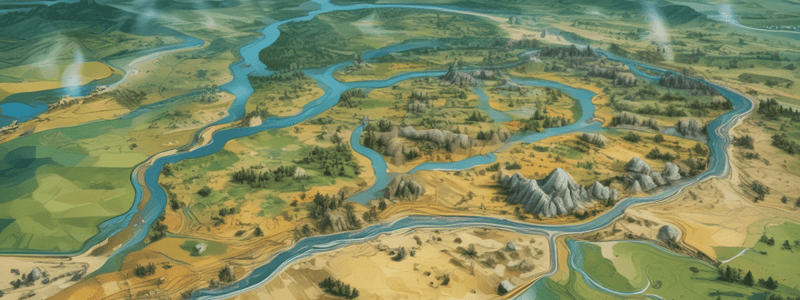Podcast
Questions and Answers
What is the primary factor that determines the type and degree of relief displacement in a radar image?
What is the primary factor that determines the type and degree of relief displacement in a radar image?
- Angle of radar-facing slope
- Local slope of the ground (correct)
- Height of the radar sensor
- Incident angle of the radar beam
What occurs when the angle of radar-facing slope is less than θi?
What occurs when the angle of radar-facing slope is less than θi?
- Layover
- Relief displacement
- Foreshortening (correct)
- Shadow
What happens when the local incident angle is 90º?
What happens when the local incident angle is 90º?
- Top and base occupy the same slant-range position
- Foreshortening reaches a maximum
- Shadow is formed (correct)
- Layover occurs
What is the pattern of horizontal displacement for a radar sensor?
What is the pattern of horizontal displacement for a radar sensor?
What is the result when the angle of radar-facing slope is equal to θi?
What is the result when the angle of radar-facing slope is equal to θi?
What is the direction of terrain distortion in radar imagery?
What is the direction of terrain distortion in radar imagery?
What is the term for the distortion of SAR imagery caused by the radar beam's interaction with the terrain?
What is the term for the distortion of SAR imagery caused by the radar beam's interaction with the terrain?
How are tall objects displaced in radar imagery?
How are tall objects displaced in radar imagery?
What is the viewing perspective of imaging radars?
What is the viewing perspective of imaging radars?
What type of relief displacement is inherent in aerial photography?
What type of relief displacement is inherent in aerial photography?
What is radar shadowing in the context of radar imagery?
What is radar shadowing in the context of radar imagery?
What is the effect of foreshortening on a radar image?
What is the effect of foreshortening on a radar image?
At what incident angle is foreshortening at a maximum?
At what incident angle is foreshortening at a maximum?
What is the trade-off when selecting incident angle?
What is the trade-off when selecting incident angle?
What happens to foreshortening effects as incident angles increase?
What happens to foreshortening effects as incident angles increase?
What is the result of layover in radar image processing?
What is the result of layover in radar image processing?
What is the main challenge in interpreting SAR images with layover?
What is the main challenge in interpreting SAR images with layover?
At what incident angle is layover more prevalent?
At what incident angle is layover more prevalent?
What is the relationship between layover and foreshortening?
What is the relationship between layover and foreshortening?
What is the result of extreme horizontal displacement in layover?
What is the result of extreme horizontal displacement in layover?
Flashcards are hidden until you start studying
Study Notes
Relief Displacement in Radar Imagery
- Primary factor influencing relief displacement is the local incidence angle (θi).
- When the angle of radar-facing slope is less than θi, displacement decreases and may be negligible.
- At a local incident angle of 90º, terrain is imaged with no relief displacement, appearing true to scale.
Horizontal Displacement Pattern
- Radar sensor experiences horizontal displacement that is dependent on the incident angle and terrain relief.
- When the angle of radar-facing slope equals θi, no further displacement occurs, maintaining a stable radar image.
Terrain Distortion Direction
- Terrain distortion in radar imagery typically occurs in the direction of the radar beam, affecting the appearance of the landscape.
SAR Imagery Distortion
- The distortion caused by the interaction of the radar beam with the terrain is called geometric distortion.
Object Displacement
- Tall objects in radar imagery are represented as displaced towards the radar, often resulting in a pronounced visual effect.
Imaging Radar Perspective
- Imaging radars provide a side-looking perspective, capturing terrain at an angle rather than straight down.
Aerial Photography
- Aerial photography inherently contains vertical relief displacement, affecting spatial accuracy.
Radar Shadowing
- Radar shadowing occurs when an object blocks the radar signal, leading to areas without radar return information.
Effects of Foreshortening
- Foreshortening causes terrain features to appear compressed, differing from their actual size.
- Foreshortening is maximized at oblique incident angles, particularly below 30º.
Incident Angle Trade-off
- Choosing a steeper incident angle enhances ground detail but may increase foreshortening and make interpretation difficult.
- As incident angles increase, foreshortening effects become more pronounced, leading to distorted imagery.
Layover in Radar Processing
- Layover occurs when the height of an object exceeds its distance from the sensor, causing overlapping echoes in radar images.
- Interpreting SAR images with layover presents a significant challenge, as features may appear incorrectly positioned.
Layover and Foreshortening Relationship
- Layover is more prominent at steep incident angles, contributing to the complexity of image interpretation.
- Extreme horizontal displacement in layover can distort the perceived dimensions and locations of objects in an image.
Studying That Suits You
Use AI to generate personalized quizzes and flashcards to suit your learning preferences.




